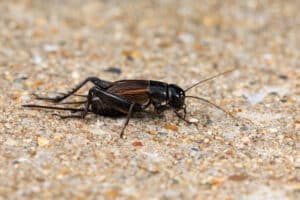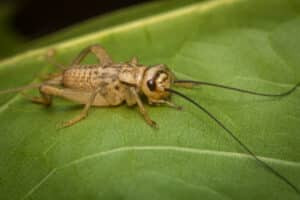Do crickets fly? Yes, some species of crickets can fly, while others cannot, influencing their behavior and how they interact with their environment; flyermedia.net provides valuable insights into cricket behavior, pest control strategies, and the fascinating world of insect flight, enhancing your understanding of these creatures. This article dives deep into the flight capabilities of different cricket species, exploring their habits, habitats, and effective methods for managing cricket infestations.
1. Understanding Cricket Flight Capabilities
Do crickets fly? The ability to fly varies greatly among different species of crickets. While some are adept fliers, others are entirely flightless. This section examines which crickets fly and why.
1.1 Which Crickets Fly?
- House Crickets: House crickets (Acheta domesticus) are known to be capable fliers, though they often prefer crawling. Their ability to fly helps them escape predators and find new food sources.
- Field Crickets: Field crickets (Gryllus species) can fly, especially when they gather in large numbers. This behavior is often observed during mating season or when resources are scarce.
- Camel Crickets: Camel crickets (Ceuthophilus species) are flightless. They lack wings and rely on jumping and crawling to move around.
1.2 Reasons Crickets Fly
- Escape Predators: Flight is a crucial defense mechanism for crickets, allowing them to quickly evade predators.
- Find Food: Flying enables crickets to cover more ground in search of food, especially when local resources are depleted.
- Mating: Some crickets fly to find mates, as it increases their chances of locating a partner over long distances.
- Relocation: When conditions become unfavorable, such as overcrowding or lack of resources, crickets may fly to new habitats.
2. Cricket Types and Their Characteristics
Understanding the different types of crickets that might be present in and around your home is the first step in effective pest management. Here are some common types you might encounter.
2.1 Field Crickets
- Appearance: Dark brown or black with rounded wings.
- Habitat: Commonly found outdoors in fields and gardens but may enter homes in search of food or shelter.
- Diet: Primarily feeds on plants, seeds, and other insects. Inside homes, they can damage cotton, linen, silk, and wool fabrics, especially if these fabrics are stained with food or sweat.
- Flight: Capable of flying, especially in large groups.
 Close-up of a field cricket showcasing its dark coloration and rounded wings
Close-up of a field cricket showcasing its dark coloration and rounded wings
2.2 Camel Crickets
- Appearance: Tan-colored with a humped back and no wings.
- Habitat: Prefers damp, dark environments such as basements, caves, and under rocks.
- Diet: Primarily feeds on fungi, decaying organic matter, and sometimes paper products.
- Flight: Cannot fly due to the absence of wings.
2.3 House Crickets
- Appearance: Yellow-brown with three dark bands on the back of their head and long, pointed wings.
- Habitat: Found both indoors and outdoors, often attracted to light.
- Diet: Feeds on fabrics, plants, and other insects. Large infestations can cause significant damage.
- Flight: Capable of flying and often attracted to light sources.
 A detailed view of a house cricket, highlighting the distinctive dark bands on its head
A detailed view of a house cricket, highlighting the distinctive dark bands on its head
3. What Attracts Crickets to Your Home?
Crickets seek shelter and sustenance, and your home might unintentionally provide both. Understanding what attracts them can help you take preventive measures.
3.1 Environmental Factors
- Warmth: Crickets often enter homes during cooler months seeking warmth.
- Moisture: Damp areas, such as basements and bathrooms, attract crickets.
- Food Sources: Accessible food, including crumbs, pet food, and garden plants near the house, can lure crickets inside.
3.2 Specific Attractants
- Outdoor Lights: Crickets are attracted to light, so leaving outdoor lights on all night can draw them to your home.
- Openings: Cracks in the foundation, gaps in doorways, and rips in window screens provide easy access for crickets.
- Vegetation: Overgrown vegetation close to your home offers shelter and a food source, making your property more attractive to crickets.
4. What Do Crickets Eat?
Crickets are omnivorous, consuming a variety of foods. Knowing their dietary preferences can help you eliminate food sources around your home.
4.1 Common Food Sources
- Plants: Stems, seeds, and leaves of various plants.
- Insects: Aphids, larvae, and even other crickets when food is scarce.
- Household Items: Fabrics, paper, plastic bags, and cardboard.
- Food Scraps: Raw vegetables (carrots, lettuce, cabbage, potatoes), fruits (oranges, bananas, apples), and pet food.
4.2 Dietary Preferences
- Vegetables: Crickets are particularly fond of raw vegetables, which provide essential nutrients.
- Fruits: Fruits rich in vitamin C, fiber, and potassium are also attractive to crickets.
- Proteins: Crickets consume insects and pet food to meet their protein requirements.
5. Effective Cricket Control Methods
Dealing with a cricket infestation requires a multi-faceted approach. Here are some effective methods for getting rid of crickets.
5.1 Preventive Measures
- Seal Entry Points: Seal cracks and holes in the foundation, repair rips in window screens, and fill gaps in doorways to prevent crickets from entering your home.
- Reduce Moisture: Fix leaky pipes and use a dehumidifier in damp areas like basements.
- Manage Lighting: Use sensor-activated outdoor lights instead of leaving them on all night.
- Maintain Landscaping: Keep vegetation trimmed and away from the house to reduce shelter and food sources for crickets.
5.2 Natural Remedies
- Sticky Traps: Place sticky traps in areas where you suspect crickets are nesting.
- Diatomaceous Earth: Sprinkle food-grade diatomaceous earth around potential entry points and nesting areas.
- Homemade Baits: Mix molasses with water and place it in shallow dishes to attract and trap crickets.
5.3 Professional Pest Control
- Inspection: A professional pest control service can identify the type of cricket and the extent of the infestation.
- Treatment: Professionals use specialized tools and technologies to effectively treat cricket infestations.
- Prevention: They can provide advice and solutions to prevent future infestations.
6. The Lifespan and Behavior of Crickets
Understanding the lifespan and behavior of crickets is essential for implementing effective control measures.
6.1 Lifespan
- Average Lifespan: The typical lifespan of a cricket is 60-90 days.
- Reproduction: Female crickets lay eggs in the autumn, which hatch after winter.
6.2 Behavior
- Chirping: Male crickets chirp to attract females and repel other males. This sound is produced by rubbing their forewings together.
- Nocturnal: Crickets are primarily nocturnal, which means they are most active at night.
- Habitat Preferences: Different species have different habitat preferences. Field crickets prefer outdoor environments, camel crickets prefer damp, dark places, and house crickets can be found both indoors and outdoors.
7. Cricket Chirping: Why Do Crickets Chirp?
Chirping is a distinctive behavior of male crickets, serving several important purposes.
7.1 Purpose of Chirping
- Attract Mates: The primary reason male crickets chirp is to attract female crickets for mating.
- Territorial Defense: Chirping can also serve as a warning to other male crickets, signaling territorial boundaries and potential competition.
7.2 How Chirping Works
- Mechanism: Crickets produce their chirping sound by rubbing their forewings together in a process called stridulation.
- Variations: Different species of crickets have unique chirping patterns, allowing females to identify potential mates of their own species.
8. Crickets and Their Impact on Fabrics
Crickets can cause significant damage to fabrics, especially in homes with large infestations.
8.1 Types of Fabrics Affected
- Natural Fibers: Crickets are particularly attracted to natural fibers such as cotton, linen, silk, and wool.
- Stained Fabrics: Fabrics stained with food or sweat are more likely to be targeted by crickets.
8.2 Preventing Fabric Damage
- Store Fabrics Properly: Store clothing and other fabrics in airtight containers to prevent crickets from accessing them.
- Clean Regularly: Regularly clean your home to remove food crumbs and other potential food sources for crickets.
- Use Repellents: Consider using natural repellents such as cedar chips or lavender sachets in closets and drawers.
9. Integrating Cricket Knowledge with Aviation
While crickets might seem unrelated to aviation, understanding their behavior can draw parallels to the importance of adaptability and problem-solving in the field of aviation.
9.1 Adaptability
- Cricket Adaptability: Crickets adapt to their environment by flying to find food and mates, or by seeking shelter in adverse conditions.
- Aviation Adaptability: Similarly, pilots and aviation professionals must adapt to changing weather conditions, mechanical issues, and other unforeseen circumstances.
9.2 Problem-Solving
- Cricket Problem-Solving: Crickets exhibit problem-solving skills by finding ways to enter homes in search of food and shelter.
- Aviation Problem-Solving: Aviation professionals must be adept at problem-solving to ensure the safety and efficiency of flights.
10. Frequently Asked Questions About Crickets (FAQ)
10.1 How Long Do Crickets Typically Live?
Crickets typically live for about 60-90 days. Their lifespan depends on environmental conditions and the availability of resources.
10.2 Why Do Crickets Chirp So Loudly?
Male crickets chirp loudly to attract females for mating and to ward off other males. The volume of their chirping helps them communicate over distances.
10.3 Do All Crickets Fly?
No, not all crickets fly. House crickets and field crickets are capable of flight, while camel crickets are wingless and cannot fly.
10.4 What Attracts Crickets to My Home?
Crickets are attracted to warmth, moisture, food sources, and light. They often enter homes seeking shelter and sustenance.
10.5 How Can I Prevent Crickets from Entering My Home?
You can prevent crickets from entering your home by sealing entry points, reducing moisture, managing outdoor lighting, and maintaining landscaping.
10.6 What Do Crickets Eat Inside Homes?
Inside homes, crickets eat fabrics, paper, food scraps, and other insects. They are omnivorous and will consume a variety of items.
10.7 Are Crickets Harmful to Humans?
Crickets are not directly harmful to humans, but they can damage fabrics and contaminate food. Their chirping can also be disruptive.
10.8 What is the Best Way to Get Rid of Crickets?
The best way to get rid of crickets is through a combination of preventive measures, natural remedies, and professional pest control services.
10.9 Can Crickets Cause Damage to My Garden?
Yes, crickets can cause damage to gardens by feeding on plants, seeds, and fruits.
10.10 Are Camel Crickets Dangerous?
Camel crickets are not dangerous. They are primarily a nuisance due to their presence in damp, dark areas.
11. The Role of Flyermedia.net in Aviation and Pest Control Insights
Flyermedia.net is a valuable resource for those seeking information on aviation, pest control, and related topics.
11.1 Comprehensive Information
Flyermedia.net offers comprehensive information on various aspects of aviation, from flight training to career opportunities. It also provides insights into pest control strategies and the behavior of common pests like crickets.
11.2 Expert Advice
The website features expert advice and guidance from industry professionals, ensuring that you receive accurate and reliable information.
11.3 Community Engagement
Flyermedia.net fosters a community of aviation enthusiasts and professionals, providing a platform for discussion, networking, and knowledge sharing.
12. Call to Action: Explore Aviation Opportunities at Flyermedia.net
Ready to take your passion for aviation to new heights? Visit flyermedia.net today to explore flight training programs, discover exciting career opportunities, and stay up-to-date with the latest industry news. Whether you dream of becoming a pilot, engineer, or aviation technician, flyermedia.net has the resources and information you need to achieve your goals.
Do crickets fly? While the answer varies by species, the world of crickets is full of fascinating behaviors and adaptations. And just as understanding cricket behavior can help you manage pests, flyermedia.net can help you navigate the exciting world of aviation. Visit us today and let your dreams take flight! Address: 600 S Clyde Morris Blvd, Daytona Beach, FL 32114, United States. Phone: +1 (386) 226-6000. Website: flyermedia.net.
13. Conclusion: Embrace Knowledge and Opportunities
In conclusion, whether you’re curious about the flight capabilities of crickets or seeking to explore the vast opportunities within the aviation industry, knowledge is your greatest asset. Understanding the nuances of insect behavior can inform effective pest control strategies, while exploring resources like flyermedia.net can pave the way for a fulfilling career in aviation. Embrace the opportunities to learn and grow, and let your curiosity guide you toward new horizons.
